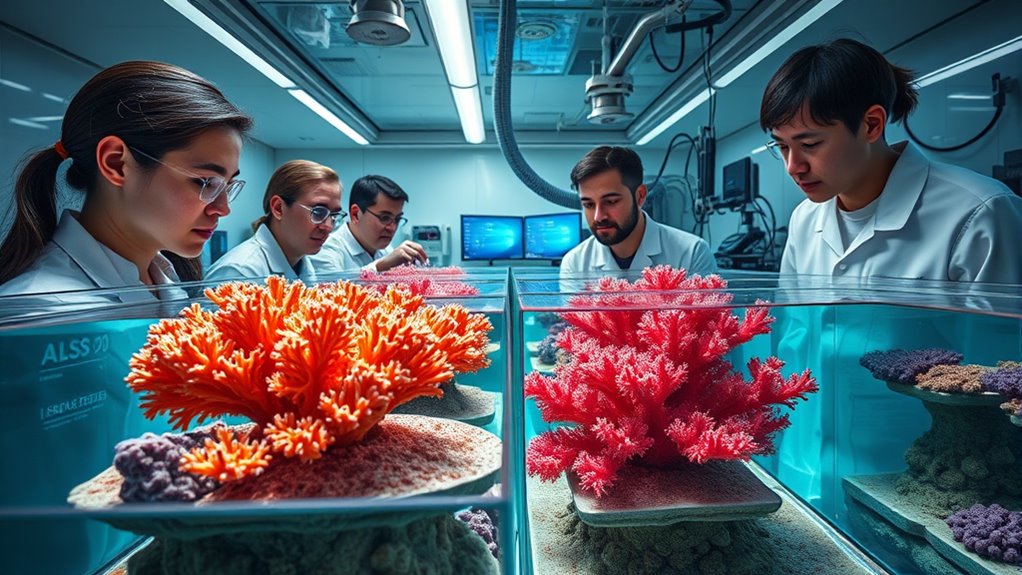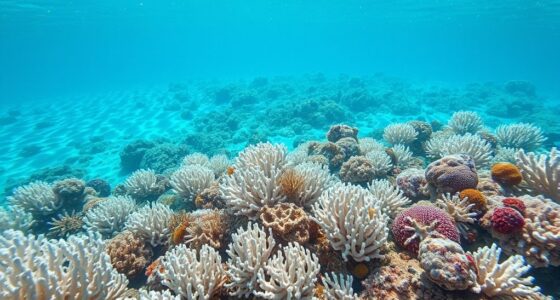Scientists have successfully bred heat-resistant corals to help save vulnerable reefs from climate change. Using genetic modification and selective breeding, they develop coral strains capable of surviving higher ocean temperatures. These resilient corals aim to stabilize damaged reefs and support marine life. Combining scientific techniques with conservation efforts, this breakthrough offers hope for reef recovery. If you look closer, you’ll discover how these innovations are changing the future of marine ecosystems.
Key Takeaways
- Scientists have developed heat-resistant coral strains through genetic modification and selective breeding.
- These corals are designed to withstand rising ocean temperatures caused by climate change.
- The initiative aims to stabilize and restore damaged coral reefs, supporting marine ecosystems.
- Combining scientific techniques with traditional conservation efforts enhances reef resilience.
- Careful testing ensures modified corals integrate ecologically without harming the environment.

Scientists have successfully bred coral that can withstand extreme heat, offering hope for the future of endangered reefs. This breakthrough marks a significant step forward in conservation strategies aimed at protecting these essential ecosystems from climate change. By leveraging advances in genetic modification, researchers are developing corals that are better equipped to survive rising ocean temperatures, which have historically caused mass bleaching and death of coral reefs worldwide. This innovative approach involves altering the coral’s genetic makeup to enhance its resilience, guaranteeing it can endure conditions that would typically be lethal.
Scientists breed heat-resistant coral to protect endangered reefs from climate change.
You might wonder how this works in practice. Basically, scientists identify gene variants associated with heat tolerance and introduce them into vulnerable coral populations. This process can involve selective breeding, where heat-resistant individuals are propagated to produce more resilient generations, or direct genetic modification techniques, such as gene editing. The goal is to create coral strains that can thrive in increasingly warm waters, therefore helping to stabilize and restore damaged reefs. These efforts are part of broader conservation strategies that combine traditional reef protection with cutting-edge scientific interventions, aiming to bolster natural resilience rather than just relying on preservation alone.
Implementing genetic modification in coral conservation offers a proactive way to adapt to climate change. Instead of waiting for natural adaptation, which can take centuries, scientists are accelerating the process to keep pace with rapid environmental shifts. Genetic modification is a powerful tool within a thorough conservation toolkit. It complements other strategies like reducing carbon emissions, establishing marine protected areas, and promoting sustainable fishing practices. Together, these efforts aim to create a multi-layered defense against the ongoing decline of coral reefs.
While the concept of genetically modified coral might raise concerns about ecological impacts, researchers emphasize careful testing and monitoring. They ensure that modified corals integrate well into existing ecosystems and do not cause unforeseen harm. The hope is that these resilient corals will serve as a foundation for reef recovery, providing habitats for countless marine species and supporting local livelihoods.
Frequently Asked Questions
How Long Does It Take for the Genetically Modified Coral to Mature?
The coral’s maturation timeline typically takes about 2 to 3 years, depending on environmental conditions and the coral species. During this period, you’ll notice steady coral growth as they develop their structure and resilience. Patience is key, as genetically modified coral needs time to establish itself fully. Proper care and ideal conditions can help guarantee healthy growth, leading to a stronger, more heat-resistant reef ecosystem over time.
Are There Any Risks to Local Ecosystems From These New Corals?
You should be aware that introducing genetically modified corals can pose risks like ecosystem imbalance and genetic contamination. These corals might outcompete native species or transfer modified genes to wild populations, disrupting natural biodiversity. While efforts aim to protect reefs, you must consider these potential ecological impacts carefully, ensuring thorough testing and monitoring to minimize harm to the local environment and maintain ecosystem health.
Can This Breeding Method Be Applied to Other Marine Species?
Like a master key opening new doors, this breeding method’s potential for other marine species hinges on understanding genetic transfer and marine adaptation. You can apply selective breeding to promote resilience, but each species has unique needs. With careful research, you may guide marine life toward survival in changing climates. However, remember that success requires patience and respect, ensuring we don’t inadvertently upset the delicate balance of ocean ecosystems.
What Are the Costs Associated With Developing Heat-Resistant Corals?
You’ll find that developing heat-resistant corals involves significant costs related to research, technology, and habitat restoration. Economic feasibility depends on securing diverse funding sources like government grants, private investments, and environmental organizations. These funds help cover laboratory work, field testing, and long-term monitoring. While costly initially, investing in resilient corals could save reefs and ecosystems, making the project worth the expense over time.
How Will These Corals Be Distributed to Affected Reefs Worldwide?
You’ll see these heat-resistant corals distributed through coral transplantation efforts, where scientists carefully introduce them to affected reefs. This approach guarantees they adapt to local conditions while promoting resilience. For global distribution, partnerships with local communities and marine organizations help scale up restoration projects. By actively transplanting and monitoring these corals worldwide, you can help boost reef recovery and resilience against climate change impacts.
Conclusion
By now, you realize that these resilient corals could be your best hope to save dying reefs. As you witness scientists blending science with hope, remember that this effort echoes the pioneering spirit of explorers like Darwin. While the challenge remains formidable, your awareness fuels support for such groundbreaking work. With continued innovation, you see a future where coral reefs might once again thrive, proving that even in the age of technology, nature’s resilience can still surprise us.









